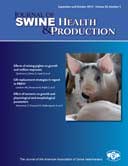Abstract:

Effect of mixing piglets affected by Escherichia coli diarrhea on growth and welfare responses
J. Quiñonero, MEng, PhD; G. Ramis, DVM, PhD; E. Lopes, DVM, MS, PhD; E. María-Dolores, DVM, PhD; Eva Armero, MEng, PhD
Complete article is available online.
PDF version is available online.
Objective: To evaluate the effects of mixing piglets prior to weaning on growth and behavioral and physiological stress markers during the preweaning and postweaning periods in the face of an outbreak of Escherichia coli diarrhea.
Materials and methods: Twenty-four sows and their litters from two adjacent rooms (A and B, 12 litters per room), and six focal piglets (three males and three females) from each litter were included. In Room B, E coli diarrhea occurred Day 12 after birth. On Day 18, the partitions between pairs of neighboring pens were removed for 12 litters, allowing piglets access to two adjoining crate areas (forming six mixed litters). Pigs were weaned on Day 28. Growth performance, behavioral stress markers, and physiological stress markers (neutrophil:lymphocyte ratio and acute phase proteins [APPs]) were measured from birth to Day 58.
Results: When colibacillosis occurred in Room B, there was a detrimental effect on growth performance, especially highlighted when piglets were mixed prior to weaning. Concentrations of APPs 2 days after weaning were higher in Room B. Mixed piglets spent more time fighting immediately after mixing; however, after weaning, mixed piglets spent less time fighting than the controls.
Implications: Mixing piglets affected by E coli diarrhea may have a detrimental effect on growth rate. Animals with colibacillosis may have higher APP concentrations. After weaning, pigs mixed pre-weaning spend less time fighting than controls, which might help them cope with the stress of weaning.
Keywords: mixing, diarrhea, growth, stress markers
![]() Cite as: Quiñonero J, Ramis G, Lopes E, et al. Effect of mixing piglets affected by Escherichia coli diarrhea on growth and welfare responses. J Swine Health Prod 2012;20(5):216-222.
Cite as: Quiñonero J, Ramis G, Lopes E, et al. Effect of mixing piglets affected by Escherichia coli diarrhea on growth and welfare responses. J Swine Health Prod 2012;20(5):216-222.
Search the AASV web site for pages with similar keywords.
